Http Www.foodpolitics.com 2017 05 What-ag-schools-really-need-to-teach-a-report

by Marion Nestle
Currently browsing posts about: Agriculture
Oct 15 2021
Weekend reading: USDA's action plans for climate change
Agriculture and climate change interact in two ways: (a) agriculture contributes to climate change, and (b) climate change affects agriculture.
In May, USDA published its plan to address (a): "Climate-Smart Agriculture and Forestry Strategy: 90-Day Progress Report."
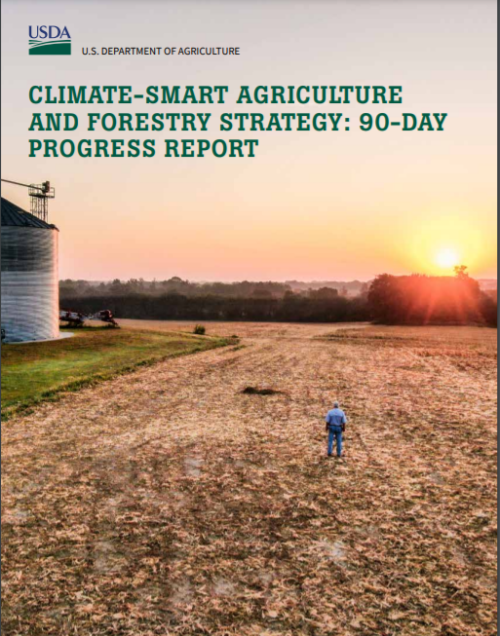
Secretary Vilsack explains:
We will look across climate science and research, forest health, outreach and education, existing programs, and new and emerging markets to advance climate-smart agriculture and forestry..Equity and justice will play a guiding role in our work…We will also prioritize actions that provide tangible, near-term benefts for low-income communities and communities of color. I am confdent that in partnership with our country's agriculture and forestry stakeholders, we can develop a strategy that is a win-win for our producers in building climate resilience, mitigating emissions, and conserving our natural resources.
Now the USDA has just issued its plan to address (b), formitigating the effects of climate change on agriculture.
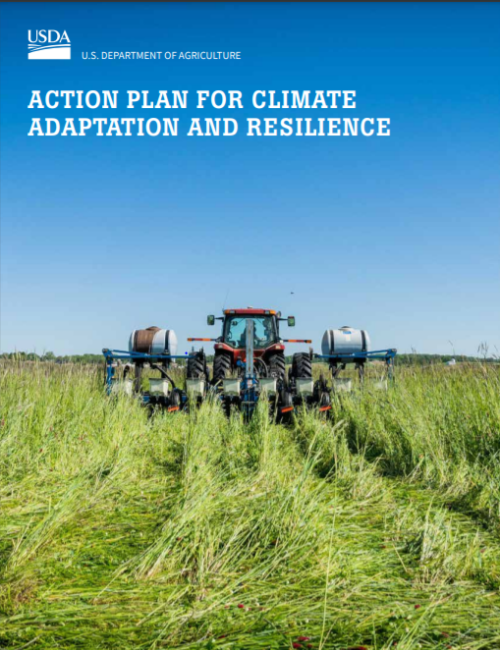
USDA Secretary Vilsack explains:
As the "People's Department," USDA is preparing to help communities across the United States, both rural and urban, plan for and build resilience to the impacts of climate change.
People's Department? If only.
USDA's strategy to help farmers deal with climate change will involve:
- Investing in soil and forest health
- Improving communication and accessibility on climate-smart strategies
- Making climate data more broadly available
- Increasing research
- Leveraging the USDA Climate Hubs, USDA's regional networks for helping farmers adapt to climate change
These reports are densely written and require much reading between the lines to figure out what USDA is really going to do and whether its actions have any hope of succeeding.
Let's hope they do.
Oct 1 2021
Weekend reading: the food system and water use
I am happy to see that USDA's Economic Research Service is back on the job and recovering somewhat from its forced move to Kansas City. I was especially interested to see this report: U.S. Food-Related Water Use Varies by Food Category, Supply Chain Stage, and Dietary Pattern.
It has three main conclusions:
- The U.S. food system, which provides the majority of domestically purchased foods and beverages, requires about one-third of the Nation's total freshwater use.
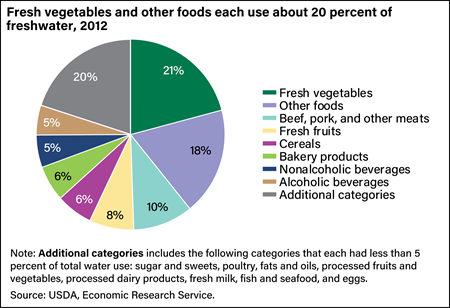
- Crop production uses over half of the water for food, while later supply chain stages also require a substantial amount of water.
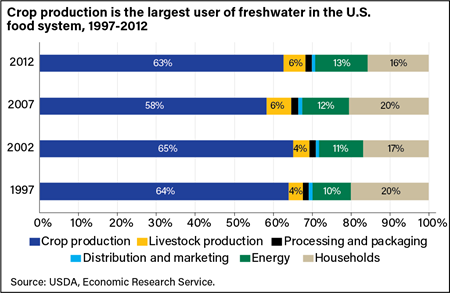
- Freshwater usage varies by the food categories that make up U.S. diets. If the U.S. population were to adopt healthier dietary patterns, food-system water use could substantially increase or decrease, depending on the dietary patterns realized.
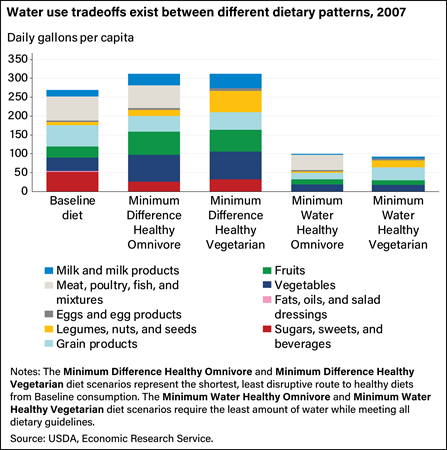
Something to consider. But all this is why PepsiCo is making such a big point about trying to reduce its water use (it takes many gallons of water to make one gallon of a bottled drink).
- PepsiCo to become 'net water positive' by 2030: 'Time is running out for the world to act on water'PepsiCo wants to become 'net water positive' by 2030, meaning the beverage giant will replenish more water than it uses to produce its food and beverage brands…. Read more
Sep 23 2021
TODAY: The UN Food Systems Summit
The long-awaited UN Food System Summit takes place today. The programme includes announcements from more than 85 heads of state and government.
The UN Food Systems Summit was announced by the UN Secretary-General, António Guterres, on World Food Day in October 2019 as a part of the Decade of Action for delivery on the Sustainable Development Goals (SDGs) by 2030. The aim of the Summit is to deliver progress on all 17 of the SDGs through a food systems approach, leveraging the interconnectedness of food systems to global challenges such as hunger, climate change, poverty and inequality. The Summit will take place during the UN General Assembly in New York on Thursday, September 23. More information about the 2021 UN Food Systems Summit can be found online: https://www.un.org/foodsystemssummit
Despite its focus on food systems approaches, it is highly controversial—as I explained in previous posts.
- The UN Summit on Food Systems 1: The UN Version
- The UN Summit on Food Systems 2: The Critique
- The UN Food Systems Pre-Summit starts in Rome TODAY: Online Access
- Weekend reading: A call to the UN Food Systems Summit: Ultra-processed foods
In preparation for today's events, Lela Nargi of The Counter provides a thoughtful summary of the issues: "The UN is holding a summit on building a sustainable future for food and ag. Why are so many people upset about it?"
The concerns:
- Who is behind the Summit? [Proponents of industrial agriculture]
- Who sets the Summit agenda? [Ditto]
- What is excluded? [Indigenous practices, regenerative agriculture, agroecology]
While watching to see how this plays out, you can take a look at:
- Information about today's #FoodSystems4People counter-demonstration
- Meat lobbying groups hard at work. As The Guardian puts it,
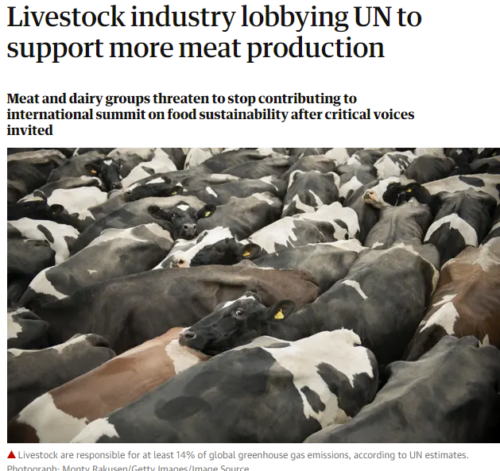
Also from The Guardian:
- UN food summit will be 'elitist' and 'pro-corporate', says special rapporteur
- Corporate colonization': small producers boycott UN food summit
And for why the issue of agroecology is so important, see Raj Patel's discussion in Scientific American: Agroecology Is the Solution to World Hunger
Marcia Ishii asks: Could FAO's partnership with CropLife International have anything to do with the disappearance of agroecology from the agenda?
Sep 22 2021
Agricultural subsidies do more harm than good?
I saw this headline in The Guardian.
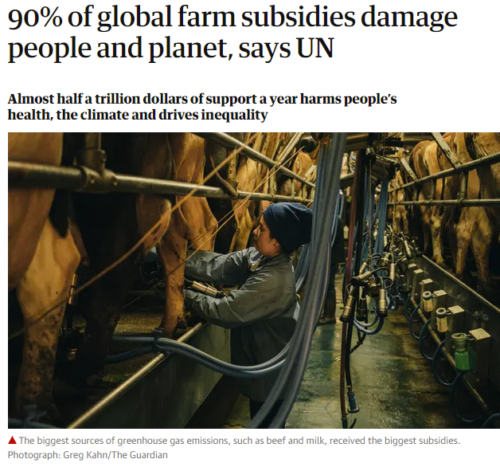
I went immediately to the UN's Food and Agriculture Organization (FAO) report: A multi-billion-dollar opportunity – Repurposing agricultural support to transform food systems.
The trends emerging from the analysis are a clear call for action at country, regional and global levels to phase out the most distortive, environmentally and socially harmful support, such as price incentives and coupled subsidies, and redirecting it towards investments in public goods and services for agriculture, such as research and development and infrastructure, as well as decoupled fiscal subsidies.
The report detail the harmful effects of current agricultural subsidy practices in promoting crops that are harmful to human health and to the environment.
Most support worldwide, through price incentives, has been given to commodities with high GHG emissions such as beef, milk and rice, which have the largest carbon footprint.
In the US, the distribution of agricultural subsidies looks like this:
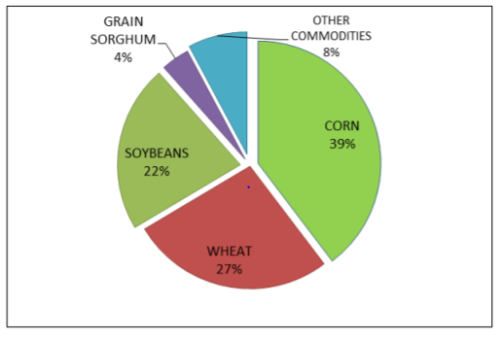
The main effect of subsidies is to cause farmers to plant more of whatever gets subsidized. One result is that corn, a water-intensive crop, is grown in places where water is scarce.
Farm income reached record levels in 2020, but one-third of farm income came from government payments (nearly $46 billion in total), largely because of increases during the pandemic.
FAO's Recommendations
- Phase out the most distorting and environmentally and socially harmful policies, such as price incentives or coupled subsidies.
- Repurpose support for high-emission or unhealthy products towards support that has environmental and health conditionalities and that promotes more sustainable food systems.
- Repurpose fiscal support to protect consumers and ensure food security and nutrition, especially for the poorest.
- Create fiscal space for agricultural support by tapping into new fiscal resources aimed at addressing climate change or stimulating the economy.
Good ideas, but good luck getting them implemented. Lobbyists for corn, ethanol, soybeans, and the like prefer to keep those subsidies coming, and they have huge power over Congress.
Sep 10 2021
Weekend reading: Break up Big Ag
Two articles on similar themes have come out recently.
Is It Time to Break Up Big Ag? — The New Yorker
Nationally, the four largest dairy co-ops now control more than fifty per cent of the market. They've been able to grow so big, in part, because of a 1922 law called the Capper-Volstead Act, which provides significant exemptions from antitrust laws for farmer-owned agricultural coöperatives. "The agricultural industry is different than other industries because Capper-Volstead allows them to combine in ways that other individuals would go to jail for," Allee A. Ramadhan, a former Justice Department antitrust attorney who led an investigation into the dairy industry, told me.
The law's protections were intended to give small, independent farmers the right to collectively bargain prices for processing and selling their goods, but many large co-ops, such as D.F.A., have increasingly come to resemble corporations.
Break Up Big Chicken — The New York Times
Most chicken that Americans eat is processed by a handful of big companies because, in recent decades, the government gave its blessing to the consolidation of poultry processing, along with a wide range of other industries. The unsurprising result: In recent years, the surviving companies took advantage of their market power to prop up the price of chicken, overcharging Americans by as much as 30 percent.
Evidence of the industry's misconduct became so blatant — thanks in part to lawsuits filed by wholesale poultry buyers — that regulators were roused from complacency. Beginning in 2019, the government has filed a series of charges against the companies and their executives.
And while we are at it, let's not forget Philip Howard's work, which I've written about previously.

Jul 29 2021
The food news from China: a roundup
I've been collecting items about China's food system as well as that country's role in ours.
Podcast: The scientist whose hybrid rice helped feed billions: A historian reflects on the life of Chinese crop scientist Yuan Longping, and the possible influence of geothermal energy production on earthquake aftershocks.
BMI and obesity trends in China:Limin Wang and colleagues use data from six representative surveys in China…The authors report that standardised mean BMI increased from 22·7 kg/m2 (95% CI 22·5–22·9) in 2004 to 24·4 kg/m2 (24·3–24·6) in 2018, and obesity prevalence from 3·1% (2·5–3·7) in 2014 to 8·1% (7·6–8·7)…in 2018, an estimated 85 million adults (95% CI 70 million–100 million; 48 million men [95% CI 39 million–57 million] and 37 million women [31 million–43 million]) aged 18–69 years in China were obese.
China says it will buy US farm products: Bloomberg News reported on Friday that, "China plans to accelerate purchases of American farm goods to comply with the phase one trade deal with the U.S. following talks in Hawaii this week.
Chinese holdings of US agricultural land: According to USDA's data on foreign ownership of US land, China owns about 192,000 agricultural acres, worth $1.9 billion. This includes land used for farming, ranching and forestry,.
The House introduces legislation to prevent China from buying U.S. farmland:Texas representative Chip Roy has introduced the "Securing America's Land from Foreign Interference Act" to "ensure that Texas's land never comes under the control of the CCP [Chinese Communist Party] by prohibiting the purchase of U.S. public or private real estate by any members of the CCP. [Comment: I'm guessing this won't get very far, in part because China is an important trading partner].
Balance of trade with China: U.S. exports of agricultural products to China totaled $14 billion in 2019, largely from soybeans ($8.0 billion); pork and pork products ($1.3 billion); cotton ($706 million); tree nuts ($606 million); and hides and skins ($412 million). U.S. imports of agricultural products from China totaled $3.6 billion in 2019, mainly from processed fruit and vegetables ($787 million); snack foods ($172 million); spices ($170 million); fresh vegetables ($136 million); and tea, including herbal tea ($131 million). [Comment: we were way ahead on the balance in 2019].
China Focus: Yeyo's Tmall launch, Chinese dietary spending trends, local cultivated meat developments and more feature in our round-up:China's first coconut yoghurt brand Yeyo's Tmall launch, Chinese dietary spending trends, local cultivated meat developments and more feature in this edition of China Focus…. Read more
'Follow, not lead': China likely to be world's largest cultivated meat consumer – but long, challenging journey ahead:China looks likely to be the world's largest consumer market of cultivated meat due its population size and government support, but a long, arduous journey lies ahead before this becomes a reality, according to an industry expert…. Read more
Deliciou-s bite: Shark Tank alumni sets sights on China with first shelf-stable plant-based meats after cross-country supermarket success:Australia-based Deliciou has its eye on China and other Asian markets with its market-first shelf-stable plant-based meat products after successful launches in both Australia's Coles and Woolworths and US' Whole Foods supermarkets…. Read more
Comment: I visited Beijing in 2019 and was surprised by the emphasis on dairy foods (never part of traditional Asian diets) and snack foods, especially for children. Weight gain is only to be expected. Current political tensions must be understood in the context of trade relations. Although we export more agricultural goods to China than we import, our overall trade balance is to import about $300 billion a year more in products made in China than we export.
Jul 28 2021
The food system is unfair to real farmers
This study inNature Foodcaught my eye: Post-farmgate food value chains make up most of consumer food expenditures globally.
The study examines the proportion of at-home food expenditures received by farmers in several countries, including the U.S.
For the U.S. it reproduces this USDA figure:
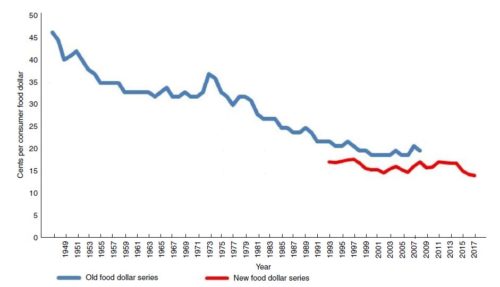
The caption:
Farm share of US consumer food expenditures. As reported in the USDA ERS food dollar series, the revenue share of consumer food expenditures has declined fairly consistently for 70 years. Data are from the USDA ERS…The new series is, on average, 3.5 cents per dollar lower than the old series over the 16 years of overlapping coverage. US real per capita incomes grew roughly 2% annually over this period.
The USDA's Food Dollar series makes this clear.
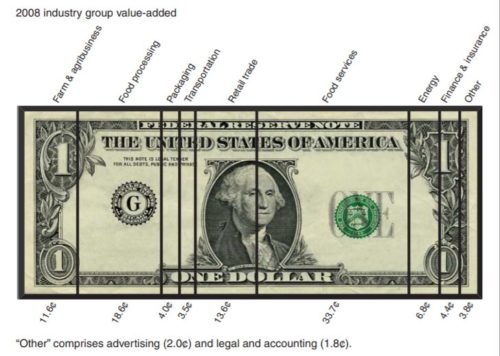
What this means is that all but about 12 cents of every food dollar goes for processing, retail, food service, and everything else that happens to a food after it is produced.
As the authors of the Nature Food study put it,
There is already growing agreement that the most unhealthy foods are largely ultra-processed products that are high in such ingredients as salt, sugars and saturated fats, that is, manufactured post-farmgate. In the average American diet, for example, only about 30% of calorie intake comes from non-processed or
mildly processed foods.Ultra-processed foods also occupy a rapidly rising share of diets in developing countries as consumers seek greater convenience and safety. The environmental impacts of ultra-processed foods have not been properly accounted for in many studies, often considering the effects of the primary commodities used for production and disregarding the processing, packaging and distribution stages.
Likewise, the post-farmgate food processing sector is a major source of single-use plastics, greenhouse gas emissions, water use and effluent discharge.
We and the planet would be healthier eating foods that are less heavily processed. This would not only be good for us, but also for farmers.
Apr 2 2021
Weekend reading: More public funding for agricultural research
The press release says it all: "New Report Highlights How Stagnant U.S. Public Funding for Agricultural Research Threatens Food Systems."
Stagnant public funding for agricultural research is threatening the future vitality of U.S. food systems – posing risks to farmer productivity and profitability, the steady supply of affordable food for consumers, and ultimately global food security, according to a new report.
The report, jointly commissioned by Farm Journal Foundation and the American Farm Bureau Federation and authored by the IHS Markit Agribusiness Consulting Group, highlights the vital importance of public funding for agricultural research and development (R&D).
New innovations are crucial so that farmers can increase their productivity and meet rising global demand for food, even as climate change intensifies. The world population is expected to reach 10 billion by 2050, and food production will need to increase by 60%-70% to meet rising demand. While private-sector funding for agricultural R&D has been increasing, U.S. public spending has been flat for the past decade.
Here's the big picture.
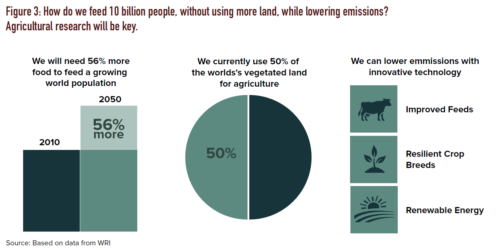
Here's what's happening with USDA research funding—flat.
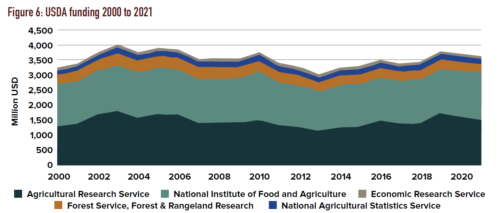
And here's what's happening with overall agricultural research. Public funding is flat. Industry funding is rising rapidly. 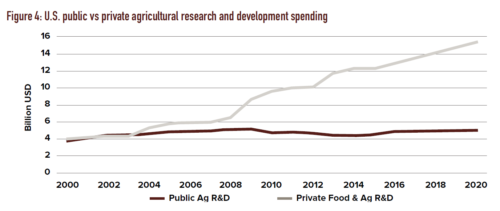
Why is this a problem? Because industry funds research aimed at developing and marketing profit-making products
This leaves research aimed at public health to be supported by the public. Research is needed to
- Increase productivity
- Improve crop protection
- Promote animal health and welfare
- Prevent animal diseases
- Protect against pandemics
- Reduce effects of climate change
Industry won't fund these research areas if there's no profit in them.
That's why more public funds need to go to agricultural research.
Here's a one page summary.
Here's the full report.
Http Www.foodpolitics.com 2017 05 What-ag-schools-really-need-to-teach-a-report
Source: https://www.foodpolitics.com/tag/agriculture/
0 Response to "Http Www.foodpolitics.com 2017 05 What-ag-schools-really-need-to-teach-a-report"
Post a Comment